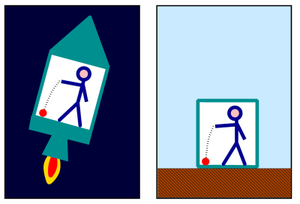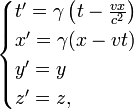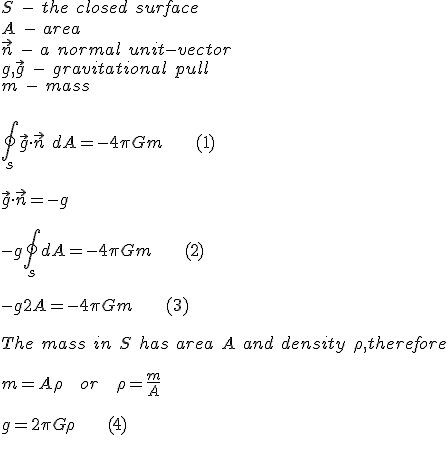Universal Acceleration
Universal Acceleration (UA) is a theory of gravity in the Flat Earth Model. UA asserts that the Earth and the observable universe are accelerating 'upward' at a constant rate of 9.8m/s^2.
This produces the effect commonly referred to as "gravity".
The traditional theory of gravitation (e.g. Newton's Law of Universal Gravitation, General Theory of Relativity, etc) is incompatible with the Flat Earth Model because it requires a large, spherical mass pulling objects uniformly toward its center.
The Basics
According to Flat Earth Theory, gravity is not the main force keeping us on the ground. Instead, there is a force that produces identical effects as observed from the surface of the earth. This force is known as "Universal Acceleration" (abbreviated as UA).
Objects on the earth's surface have weight because all sufficiently massive celestial bodies are accelerating upward at the rate of 9.8 m/s^2 relative to a local observer immediately above said body. The mass of the earth is thought to shield the objects atop it from the direct force of UA. Alternatively, it is possible that the force of UA can actually pass through objects, but its effect on smaller bodies is negligible (similar to gravity in RET cosmology, which only has a noticeable affect on very large objects).
However, not all Flat Earth models dismiss the theory of gravity. The Davis Model proposes that the earth is an infinite plane exerting a finite gravitational pull (g), which is consistent with Gauss's Law.
Equivalence Principle
The phenomenon we observe everyday when falling is currently substantiated in modern physics by what is called the Equivalence Principle.
This principle in physics states that in a relative frame of reference, it is not possible to locally discern whether the frame is accelerating upwards, or if the object inside the frame is affected by gravity.
Several frequently asked questions are, "How is that I can jump and then come back down?" and "Why is it that I feel as though I'm being pulled toward the earth?"
Since the Earth is pushing you upwards, you are moving at the same speed as the Earth, much like when you are sitting in a car, the car is pushing you along. When you jump, your upward velocity is for a moment, greater than the Earth's so you rise above it. But after a few moments, the Earth's increasing velocity due to its acceleration eventually catches up.
Accelerating to the Speed of Light
It is a common misconception that if we were to continuously accelerate over time, we would eventually be moving faster than the speed of light. This is of course, incorrect as nothing with mass may do so.
According to the Special theory of Relativity, the Earth can accelerate forever without reaching or passing the speed of light. Relative to an observer on Earth (more specifically, an observer who recently left the Earth, e.g. a person who jumped up), the Earth's acceleration will always be 1g. Relative to an inertial observer in the universe, however, the Earth's acceleration decreases as the its velocity approaches c. It all depends on our frame of reference to measure and explain the Earth's motion. Thus, despite what most people think, there is no absolute "speed" or velocity of the Earth.
A brief explanation of special relativity
Special relativity (SR) (also known as the special theory of relativity or STR) is the physical theory of measurement in inertial frames of reference proposed in 1905 by Albert Einstein (after the considerable and independent contributions of Hendrik Lorentz, Henri Poincaré and others) in the paper "On the Electrodynamics of Moving Bodies". It generalizes Galileo's principle of relativity–that all uniform motion is relative, and that there is no absolute and well-defined state of rest (no privileged reference frames)–from mechanics to all the laws of physics, including both the laws of mechanics and of electrodynamics, whatever they may be. Special relativity incorporates the principle that the speed of light is the same for all inertial observers regardless of the state of motion of the source.
This theory has a wide range of consequences, including counter-intuitive ones such as length contraction, time dilation and relativity of simultaneity, contradicting the classical notion that the duration of the time interval between two events is equal for all observers. (On the other hand, it introduces the space-time interval, which is invariant.) Combined with other laws of physics, the two postulates of special relativity predict the equivalence of matter and energy, as expressed in the mass-energy equivalence formula E = mc2, where c is the speed of light in a vacuum. The predictions of special relativity agree well with Newtonian mechanics in their common realm of applicability, specifically in experiments in which all velocities are small compared to the speed of light. The theory is termed "special" because it applies the principle of relativity only to frames in uniform relative motion.
Special relativity reveals that c is not just the velocity of a certain phenomenon, namely the propagation of electromagnetic radiation (light)—but rather a fundamental feature of the way space and time are unified as spacetime. A consequence of this is that it is impossible for any particle that has mass to be accelerated to the speed of light.
Why doesn't the Earth's velocity reach the speed of light?
Let's define the event to have space-time coordinates ![]() in system S and
in system S and ![]() in S'. Then the Lorentz transformation specifies that these coordinates are related in the following way:
in S'. Then the Lorentz transformation specifies that these coordinates are related in the following way:
where  is called the Lorentz factor and c is the speed of light in a vacuum.
is called the Lorentz factor and c is the speed of light in a vacuum.
Differential Equation for velocity on earth:

Limit as t -> infinity = c
As you can see, it is impossible for dark energy to accelerate the Earth past the speed of light.
Explanations for Universal Acceleration
The are several explanations for UA. As it is difficult for proponents of Flat Earth Theory to obtain grant money for scientific research, it is nigh on impossible to determine which of these theories is correct.
Dark Energy
This model proposes that the disk of our Earth is lifted by dark energy, an unknown form of energy which, according to globularist physicists, makes up about 70% of the universe. The origin of this energy is unknown.
Davis Plane
This model states that there is an infinite plane of exotic matter somewhere below the disk, pushing in the opposite manner of traditional gravity. This is a recent theory, and is in progress.
Variations in Gravity
Q: Why does gravity vary with altitude?
A: According to the model of Celestial Gravitation the Moon and Stars have a slight gravitational pull. This is given as an answer to tidal effects and variations of gravity with altitude. Other models reject the concept of gravity entirely and question whether those slight variations in gravity actually exist. See: Variations in Gravity
Terminal Velocity
In the Round Earth model, terminal velocity happens when the acceleration due to gravity is equal to the acceleration due to drag. In the Flat Earth model, however, there are no balanced forces: terminal velocity happens when the upward acceleration of the falling object is equal to the upward acceleration of the Earth.
Q: How is terminal velocity defined within the Flat Earth Theory?
A: When the acceleration of the falling object is equal to the acceleration of the Earth, the object has reached terminal velocity relative to the Earth.
Alternatives to Universal Acceleration
The Davis model, suggested by John Davis, states that gravity does indeed exist. In this model, the Earth is an infinite disk with finite gravity. This was mathematically demonstrated with the following:
See Also
Flat Earth Gravity Topics
- Universal Acceleration - The Universal Accelerator Main Page
- Equivalence Principle - Gravity behaves as if the Earth is accelerating upwards
- Evidence for Universal Acceleration - Experiments and background foundation showing that Earth is accelerating upwards
- Variations in Gravity - Various experiments have failed to find variations in gravity or violations of the Equivalence Principle
- Gravitational Time Dilation - Time dilates in accordance with the uniform prediction of the Equivalence Principal to various heights
Round Earth Gravity Topics
- Weight Variation by Latitude - An uncontrolled weight change experiment which is not performed in a vaccum chamber
- Cavendish Experiment - An inconsistent short range attraction experiment
- Gravimetry - Gravimeters are described to be seismometers by mainstream sources
- Isostasy - The mass attraction of mountains and continents does not behave in accordance with 'gravity'




